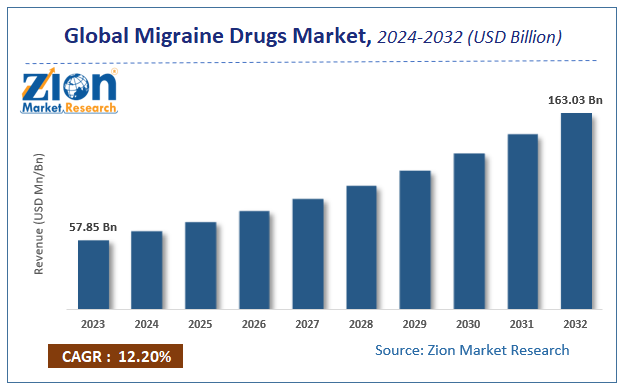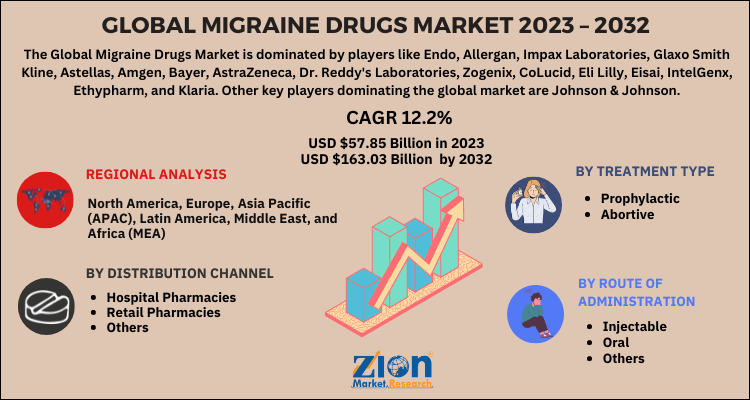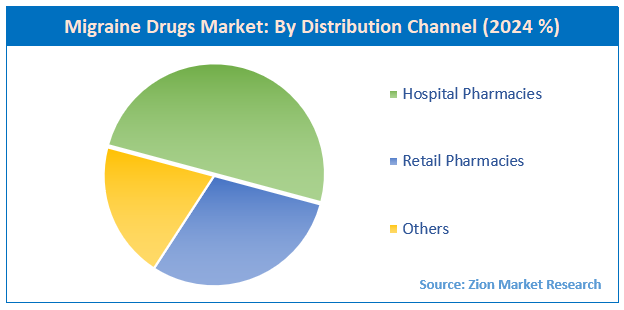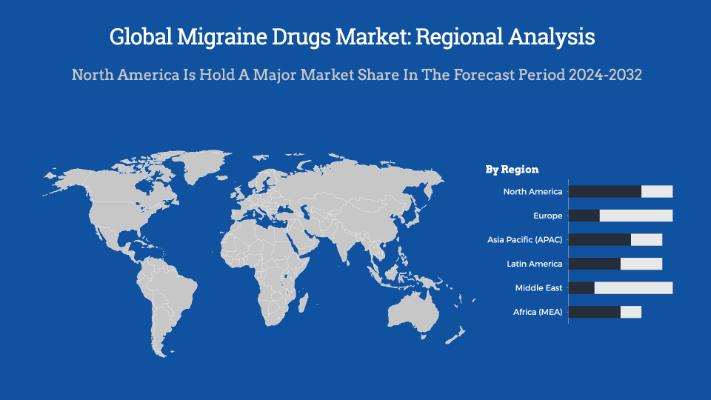Migraine Drugs Market Size, Share, Trends, Analysis To 2032

Migraine Drugs Market By treatment type (prophylactic and abortive), By route of administration (injectable, oral, and others), By distribution channel (hospital pharmacies, retail pharmacies, and others) And By Region: - Global and Regional Industry Overview, Market Intelligence, Comprehensive Analysis, Historical Data, and Forecasts, 2024-2032
| Market Size in 2023 | Market Forecast in 2032 | CAGR (in %) | Base Year |
|---|---|---|---|
| USD 57.85 Billion | USD 163.03 Billion | 12.2% | 2023 |
Description
Global Migraine Drugs Market: Insights
According to the report published by Zion Market Research, the global Migraine Drugs Market size was valued at USD 57.85 Billion in 2023 and is predicted to reach USD 163.03 Billion by the end of 2032. The market is expected to grow with a CAGR of 12.2% during the forecast period. The report analyzes the global Migraine Drugs Market's growth drivers, restraints, and impact on demand during the forecast period. It will also help navigate and explore the arising opportunities in the Migraine Drugs industry.
Key Insights
- As per the analysis shared by our research analyst, the migraine drugs market is anticipated to grow at a CAGR of 12.2% during the forecast period (2024-2032).
- The global migraine drugs market was estimated to be worth approximately USD 57.85 billion in 2023 and is projected to reach a value of USD 163.03 billion by 2032.
- The growth of the migraine drugs market is being driven by rising prevalence of migraines worldwide and increasing awareness about effective treatment options.
- Based on the treatment type, the prophylactic segment is growing at a high rate and is projected to dominate the market.
- On the basis of route of administration, the injectable segment is projected to swipe the largest market share.
- In terms of distribution channel, the hospital pharmacies segment is expected to dominate the market.
- By region, North America is expected to dominate the global market during the forecast period.
Global Migraine Drugs Market: Overview
About 12–14% of people around the world suffer from a Migraine; it is a type of a headache. According to regional and international rules, migraine is classified by the nature of the attack and its frequency into a chronic migraine and episodic migraine. Prophylactic and abortive are 2 treatments available for the relief of this headache type. Prophylactic treatment is offered to patients suffering from a chronic migraine in order to avoid migraine attacks utilizing medications like topiramate, botulinum toxin, and others. Abortive treatment is offered to terminate severe migraine attack and includes medication like ergot alkaloids, triptans, and others.
Global Migraine Drugs Market: Growth Factors
The increasing awareness regarding a migraine and various options available for its treatment are the major factors boosting the growth of the global migraine drugs market. A number of organizations including the American Headache and Migraine Association are taking efforts to spread awareness about a migraine and hence coming up with programs and providing support to patients so as to spread awareness regarding the disease and further disorders related to a headache. Due to the increasing number of migraine incidences and rising number of unmet needs in the global migraine drugs market, a number of companies are planning to invest in the migraine drugs R&D. This, in turn, is anticipated to propel the global migraine drugs market growth in the near future.
Recent Development
- In March 2023, Zavzpret, a nasal spray for the acute treatment of migraine, was developed by Biohaven Pharmaceuticals (now owned by Pfizer). It is a CGRP receptor antagonist, offering a fast-acting alternative for patients who prefer not to take oral medications or need rapid relief.
- In September 2021, Qulipta, an oral CGRP receptor antagonist taken daily for the preventive treatment of episodic and chronic migraine, was approved, positioning it as a key competitor to the existing injectable CGRP monoclonal antibodies.
- In May 2021, Nurtec ODT (rimegepant) had its use expanded to include the preventive treatment of episodic migraine, making it the first drug approved for both acute and preventive use.
- In May 2022, Pfizer acquired Biohaven Pharmaceuticals for approximately $11.6 billion. This acquisition gave Pfizer full rights to Nurtec ODT (rimegepant) and the experimental nasal spray, zavegepant (later approved as Zavzpret), as a strategic move to expand its presence in the growing migraine market.
Migraine Drugs Market: Report Scope
| Report Attributes | Report Details |
|---|---|
| Report Name | Migraine Drugs Market |
| Market Size in 2023 | USD 57.85 Billion |
| Market Forecast in 2032 | USD 163.03 Billion |
| Growth Rate | CAGR of 12.2% |
| Number of Pages | 216 |
| Key Companies Covered | Endo, Allergan, Impax Laboratories, Glaxo Smith Kline, Astellas, Amgen, Bayer, AstraZeneca, Dr. Reddy's Laboratories, Zogenix, CoLucid, Eli Lilly, Eisai, IntelGenx, Ethypharm, and Klaria. Other key players dominating the global market are Johnson & Johnson, Luitpold Pharmaceuticals, Kowa Pharmaceuticals America, Merck, Meda, Pfizer, OptiNose, Raptor, Pozen, SUDA, RedHill, TG Therapeutics, Teva, Winston Pharmaceuticals, and NValeant |
| Segments Covered | By treatment type, By route of administration, By distribution channel and By Region |
| Regions Covered | North America, Europe, Asia Pacific (APAC), Latin America, Middle East, and Africa (MEA) |
| Base Year | 2023 |
| Historical Year | 2018 to 2022 |
| Forecast Year | 2024 - 2032 |
| Customization Scope | Avail customized purchase options to meet your exact research needs. Request For Customization |
Global Migraine Drugs Market: Segmentation
The global migraine drug market is segmented on the basis of treatment type, route of administration, and distribution channel. All the segments have been analyzed based on present and future trends and the market is estimated from 2024 to 2032.
On the basis of Treatment Type, the global migraine drugs market is segmented as prophylactic and abortive.
The prophylactic treatment segment is further sub-segmented as topiramate, botulinum toxin, and others. The abortive treatment segment is further sub-segmented as ergot alkaloids, triptans, and others.
On the basis of route of Administration, the global market is classified as injectable, oral, and others.
The others segment is further sub-segmented as transdermal patches and nasal sprays.
On the basis of the Distribution Channel, the global migraine drugs market is diversified as hospital pharmacies, retail pharmacies, and others.
The Regional segment includes the current and forecast demand for North America, Europe, Asia Pacific, Latin America, and the Middle East and Africa.
Migraine Drugs Market Dynamics
Key Growth Drivers
The migraine drugs market is experiencing significant growth, primarily driven by the rising global prevalence of migraine disorders. According to the World Health Organization, migraines affect a large percentage of the global population, and their prevalence is increasing, which necessitates improved pharmaceutical interventions. Another major driver is the advancement in medication and treatment approaches, particularly the introduction of novel drug classes like calcitonin gene-related peptide (CGRP) inhibitors and gepants. These new drugs offer superior efficacy and a more targeted mechanism of action compared to older treatments, providing better management options for both acute and preventive care. Furthermore, a growing awareness and education about migraine as a neurological disease, rather than just a headache, are encouraging more patients to seek professional help and leading to earlier diagnosis and treatment.
Restraints
Despite the market's strong growth, it faces several significant restraints. One of the main challenges is the high cost of novel migraine drugs, particularly the new CGRP inhibitors. These drugs are often priced at a premium, which can make them less accessible to patients and a major burden on healthcare systems, especially in countries with less robust insurance or reimbursement policies. Another significant restraint is the side effects associated with existing migraine drugs, which can lead to poor patient adherence and a discontinuation of treatment. For example, some older medications may cause nausea, dizziness, or other adverse effects that can be as debilitating as the migraine itself. Additionally, the availability of low-cost, over-the-counter alternatives for pain relief, such as NSAIDs, can reduce the demand for more expensive prescription drugs.
Opportunities
The migraine drugs market is ripe with opportunities for innovation and expansion. The increasing focus on personalized medicine and targeted therapies creates a strong growth avenue. As researchers gain a better understanding of the genetic and biological triggers of migraines, they can develop more tailored and effective treatments for specific patient populations. The expansion of the market into emerging economies, particularly in the Asia-Pacific region, presents a vast and untapped market due to a large, underserved patient population and a rapidly developing healthcare infrastructure. Furthermore, the development of new drug delivery methods, such as nasal sprays, injectables, and transdermal patches, offers a significant opportunity to provide faster relief and a more convenient experience for patients who may have difficulty with oral medications due to nausea or other symptoms.
Challenges
The migraine drugs market faces a number of complex challenges. A major challenge is the misdiagnosis and under-diagnosis of migraines, particularly in developing regions where there is a lack of awareness and a shortage of specialized healthcare professionals. This can lead to patients receiving inadequate or improper treatment, which not only impacts their quality of life but also limits the market's growth potential. The industry must also contend with intense competition from a large number of global and local players, which can lead to pricing pressures and a need for continuous research and development to maintain a competitive edge. Lastly, the industry must address the stringent and lengthy regulatory approval processes for new drugs, which can delay product launches and increase the cost of R&D, thereby slowing down the introduction of innovative therapies to the market.
Global Migraine Drugs Market: Regional Analysis
Asia Pacific is anticipated to dominate the global migraine drugs market and is further expected to continue this trend in the near future. This high growth is mainly owing to the increasing number of people suffering from migraines and rising public awareness of the disease in this region. In addition, China and India are the major developing countries contributing to the global migraine drugs market growth in the Asia Pacific region; this is mainly due to the high occurrence of migraines in these countries. Rising focus on niche products and their launches, along with high penetration of novel drug manufacturers, will further have a positive impact on the growth of the global migraine drugs market in the near future.
Global Migraine Drugs Market: Competitive Players
Some of the major players in the global migraine drugs market include
- Endo
- Allergan
- Impax Laboratories
- Glaxo Smith Kline
- Astellas
- Amgen
- Bayer
- AstraZeneca
- Dr. Reddy's Laboratories
- Zogenix
- CoLucid
- Eli Lilly
- Eisai
- IntelGenx
- Ethypharm
- Klaria.
Other key players dominating the global market are
- Johnson & Johnson
- Luitpold Pharmaceuticals
- Kowa Pharmaceuticals America
- Merck
- Meda
- Pfizer
- OptiNose
- Raptor
- Pozen
- SUDA
- RedHill
- TG Therapeutics
- Teva
- Winston Pharmaceuticals
- NValeant.
The Global Migraine Drugs Market segments are as follows:
By Treatment Type
- Prophylactic
- Abortive
By Route Of Administration
- Injectable
- Oral
- Others.
By Distribution Channel
- Hospital Pharmacies
- Retail Pharmacies
- Others
Global Migraine Drugs Market: Regional Segment Analysis
- North America
- The U.S.
- Europe
- The UK
- France
- Germany
- The Asia Pacific
- China
- Japan
- India
- Latin America
- Brazil
- The Middle East and Africa
What Reports Provide
- Full in-depth analysis of the parent market
- Important changes in market dynamics
- Segmentation details of the market
- Former, on-going, and projected market analysis in terms of volume and value
- Assessment of niche industry developments
- Market share analysis
- Key strategies of major players
- Emerging segments and regional markets
- Testimonies to companies in order to fortify their foothold in the market.
Table Of Content
FrequentlyAsked Questions
About 12–14% of people around the world suffer from a Migraine; it is a type of a headache. According to regional and international rules, migraine is classified by the nature of the attack and its frequency into a chronic migraine and episodic migraine. Prophylactic and abortive are 2 treatments available for the relief of this headache type. Prophylactic treatment is offered to patients suffering from a chronic migraine in order to avoid migraine attacks utilizing medications like topiramate, botulinum toxin, and others. Abortive treatment is offered to terminate severe migraine attack and includes medication like ergot alkaloids, triptans, and others.
The Migraine Drugs Market was valued at USD 57.85 Billion in 2023.
The Migraine Drugs Market is expected to reach USD 163.03 Billion by 2032, growing at a CAGR of of 12.2% between 2024 to 2032.
The increasing awareness regarding a migraine and various options available for its treatment are the major factors boosting the growth of the global migraine drugs market. A number of organizations including the American Headache and Migraine Association are taking efforts to spread awareness about a migraine and hence coming up with programs and providing support to patients so as to spread awareness regarding the disease and further disorders related to a headache. Due to the increasing number of migraine incidences and rising number of unmet needs in the global migraine drugs market, a number of companies are planning to invest in the migraine drugs R&D. This, in turn, is anticipated to propel the global migraine drugs market growth in the near future.
Migraine Drugs Market players such as Endo, Allergan, Impax Laboratories, Glaxo Smith Kline, Astellas, Amgen, Bayer, AstraZeneca, Dr. Reddy's Laboratories, Zogenix, CoLucid, Eli Lilly, Eisai, IntelGenx, Ethypharm, and Klaria. Other key players dominating the global market are Johnson & Johnson, Luitpold Pharmaceuticals, Kowa Pharmaceuticals America, Merck, Meda, Pfizer, OptiNose, Raptor, Pozen, SUDA, RedHill, TG Therapeutics, Teva, Winston Pharmaceuticals, and NValeant.
The Regional segment includes the current and forecast demand for North America, Europe, Asia Pacific, Latin America, and the Middle East and Africa.
HappyClients
Zion Market Research
Tel: +1 (302) 444-0166
USA/Canada Toll Free No.+1 (855) 465-4651
3rd Floor,
Mrunal Paradise, Opp Maharaja Hotel,
Pimple Gurav, Pune 411061,
Maharashtra, India
Phone No +91 7768 006 007, +91 7768 006 008
US OFFICE NO +1 (302) 444-0166
US/CAN TOLL FREE +1 (855) 465-4651
Email: sales@zionmarketresearch.com
We have secured system to process your transaction.
Our support available to help you 24 hours a day, five days a week.
Monday - Friday: 9AM - 6PM
Saturday - Sunday: Closed








